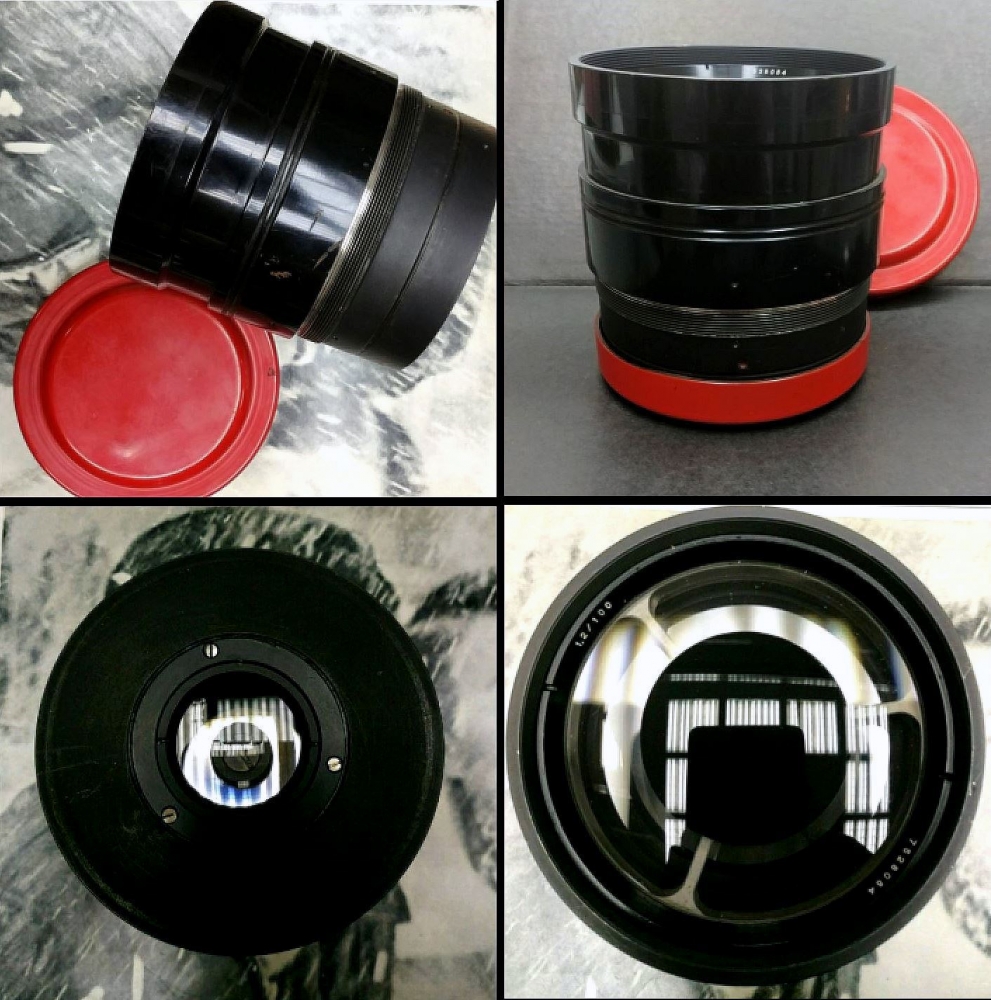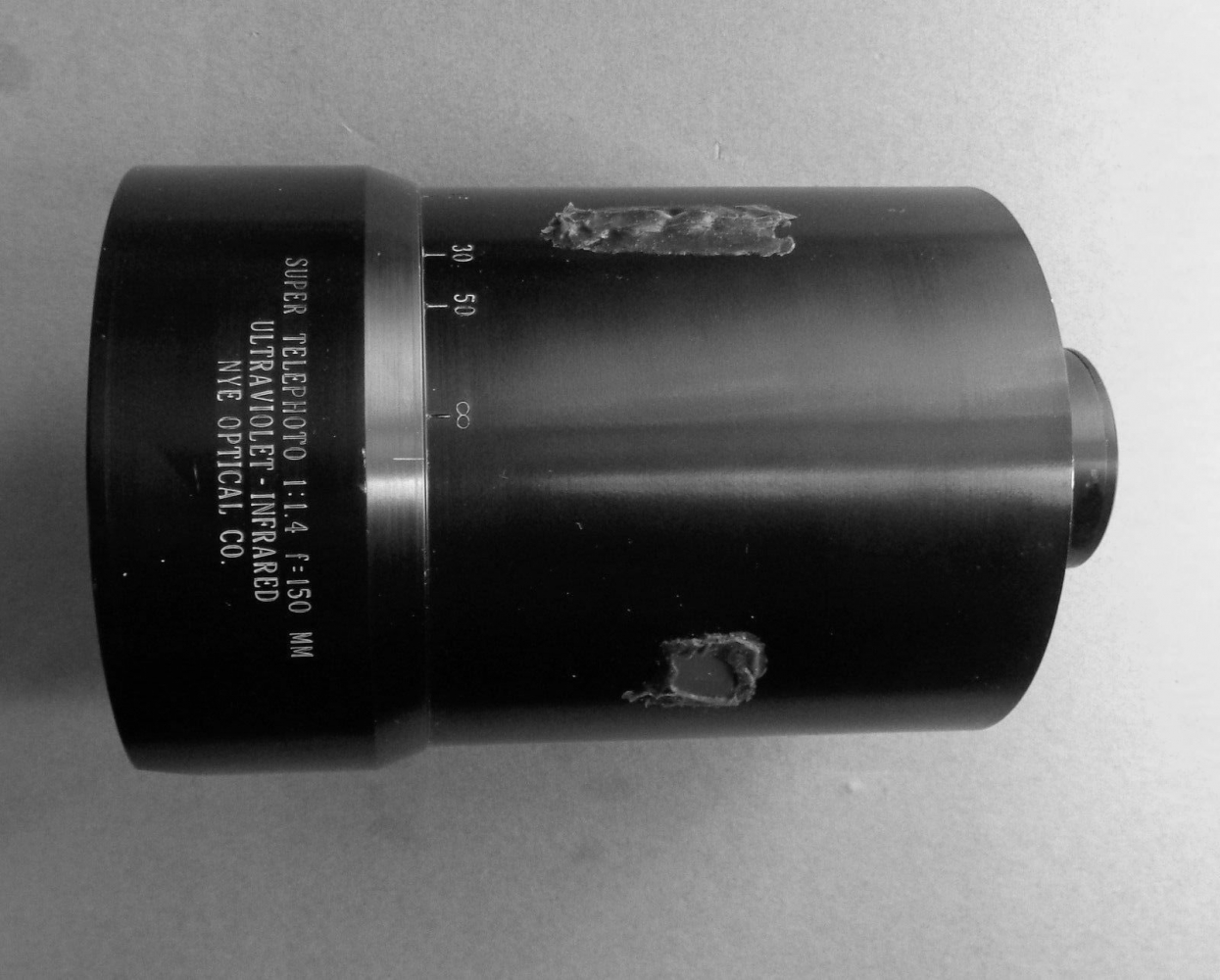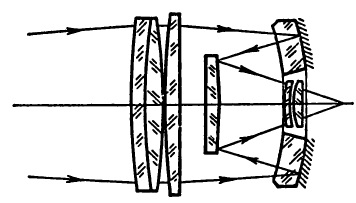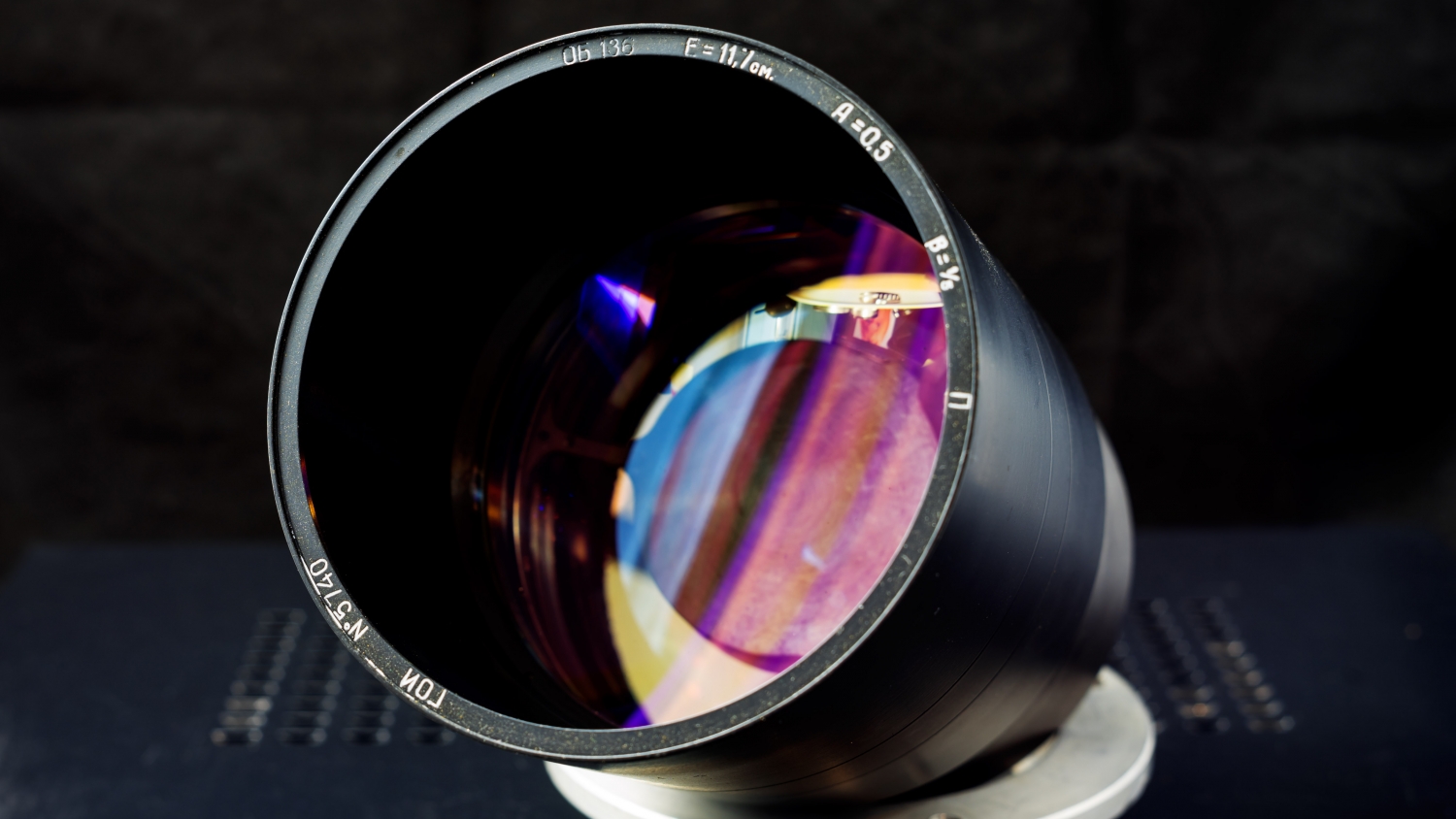| View previous topic :: View next topic |
| Author |
Message |
eggplant


Joined: 27 May 2020
Posts: 517
|
 Posted: Thu Nov 18, 2021 6:24 pm Post subject: Circa 1949- Objective lenses f/1 and greater Posted: Thu Nov 18, 2021 6:24 pm Post subject: Circa 1949- Objective lenses f/1 and greater |
 |
|
eggplant wrote:
From https://ieeexplore.ieee.org/document/7247928/ converted using Imagemagick. What I'll post below is from the spherical, refractive lenses section- aspherics and reflecting objectives are discussed (this is a very complete discussion!), but what's below is of interest to most people, probably.
The full article will be posted eventually, as it's an extremely illuminating discussion of lens design almost lost to time. For the time being, I will copy the text pertaining to the diagram above:

Full res https://i.postimg.cc/zqL5TsYz/image.jpg
| Quote: |
A substantial number of large-aperture refracting objectives follow the Petzval design, outstanding for its excellent correction over a small field. In its fundamental form the Petzval lens is essentially a pair of widely spaced achromats, each approximately corrected for spherical aberration. The earliest of these modifications is the Ziess R-Biotar f0.85, Fig. 2a, computed by Merte [8] which in the 4.5-centimeter focal length covers most of the 16-mm frame reasonably well.
In this design the creation of an air space between elements 1 and 2 of the original Petzval lens and provision of another collective element (3) have provided the necessary additional degrees of freedom. Another design, Fig. 2b, of aperture f/0.9, has been developed by Warmisham, [9] in which the large aperture is obtained, by the addition of a collective meniscus immediately following the first doublet, a procedure favorable to the reduction of spherical aberration. Fig. 2c shows the Taylor, Taylor, and Hobson f/0.8 radiographic lens, [10] a design in which the rear component of the basic Petzval configuration is split into two doublets, again taking advantage of reduced spherical aberration through dividing. The f/0.6 lens of Kaprelian, [11] Fig. 2d, adds another element to the R-Biotar upon which it is based in an attempt to obtain better spherical and chromatic correction and to increase the back focal length by a shift in power.
Another group of large-aperture objectives is based upon the excellent six-piece Gauss type, the principal defects of which are higher order astigmatism and oblique spherical aberration. Leitz, [12] Fig. 2e, has utilized a modification of the Gauss type which comprises the addition of two crown elements, one before the dispersing menisci and one after the menisci, to extend the aperture to f/0.85. The 7.5-centimeter Leitz objective has an acceptable field of about one inch diameter and covers the 35—mm frame for cine fluorography. An f/1 lens produced by Wray for radiography is of the same general type; here the additional collective element has been provided only at the long conjugate end and the second dispersive element appears as a singlet. The Wray lens, in common with most objectives intended for radiography, is especially corrected for use at short conjugates.
An f/0.95 Gauss-type objective of Zeiss [13] provides additional power through the provision of a second rear crown and includes a field flattener close to the focal plane, Fig. 21. Herzberger [14] has designed an objective, Fig. 2g, of f/0.8 aperture which utilizes a front group comprising a complete, well-corrected Gauss objective followed by a rear-collective group of three elements based upon a system originated by Luboshez. [15, 16] The Herzberger objective provides for generally good correction. The Astro Tachon f/1 of Bielicke [17] utilizes the front components of the Gauss type in combination with rear components derived from the air-space type. Bielicke’s f/1 design has been modified by the addition of another element to produce the f/0.95 Tachon, Fig. 2h.
Another group of extreme-aperture objectives derives from the Gauss type to form a separate and distinct class which results when the second dispersive meniscus is removed, the last element made strongly collective, and a meniscus introduced between the front element and the dispersive meniscus. Lee, [18] Fig. 2i, achieves an aperture of f/1 by this approach and in another form, Fig. 2j, also of f/1 aperture, the rear element is split in two without altering the first six radii or changing glasses. Lee [19] has also produced an f/1 design, Fig. 2k, in which the front element of this general arrangement is replaced with a cemented doublet to provide additional surfaces. Closely following this latter arrangement, Fig. 21, is the f/1 Taylor and Hobson [10] radiographic lens in which an air space has been introduced between the first two elements.
Other lenses not directly identified with the above type groupings include an f/1 modification of the Ernostar by Bertele, [20] Fig. 2m, in which the rear crown has been replaced by a pair of crowns; a variation of the Plasmat by Rudolph, [21] Fig. 2n, for which an aperture of f/1 is claimed; and two f/1 designs, Figs. 2o and 2p, by Warmisharn, [22, 23] the first of which is derived from the four-piece air-space Dogmar design while the second is a modification of the Speed Panchro. Hopkins, Evans, Covell, and Feder [24] have described a six-piece f/1 objective based upon a microscope objective, or Petzval, design in which the well-corrected image falls upon a curved field to which the film is deformed pneumatically.
Of historic interest is an early and unusual design of Minor [26] for which an aperture of f/0.5 is claimed. Minor’s design began with the computation of a four-piece air-space objective providing for the addition, later, of three more elements, one in front and two behind the basic objective to obtain increased aperture with the apparent utilization of specific surfaces to correct for specific aberrations. The final large aperture claimed was to be obtained by adding to the existing system a pair of rear elements which was intended to constitute a large-aperture rear attachment.
Of these twenty designs, six are currently, or have at some time been commercially available. Another, a Petzval lens, nominally of f/0.99 aperture, has not been considered here because its actual effective aperture is about f/1.4. Objectives which do not appear even approximately to fulfill the sine condition, such as one dry objective of f/0.3 aperture, [26] have been omitted from the present paper. Other large-aperture objectives having only partial corrections [27] or intended for nonphotographic uses, [28] may be of interest in some applications. |
|
|
| Back to top |
|
 |
kds315*


Joined: 12 Mar 2008
Posts: 16654
Location: Weinheim, Germany
Expire: 2021-03-09
|
 Posted: Sat Nov 20, 2021 9:47 am Post subject: Posted: Sat Nov 20, 2021 9:47 am Post subject: |
 |
|
kds315* wrote:
I have a few of those very fast lenses, especially the f0.85 R-Biotar (there is a f0.73 version too).
Always been fascinated with those ultrafast lenses...
What should be added is, that there are also ultrafast catadioptric lenses.
PS: "...and greater" you surely meant "...and faster" as greater would be a larger f-number,
which would indicate a slower lens 
_________________
Klaus - Admin
"S'il vient a point, me souviendra" [Thomas Bohier (1460-1523)]
http://www.macrolenses.de for macro and special lens info
http://www.pbase.com/kds315/uv_photos for UV Images and lens/filter info
https://www.flickr.com/photos/kds315/albums my albums using various lenses
http://photographyoftheinvisibleworld.blogspot.com/ my UV BLOG
http://www.travelmeetsfood.com/blog Food + Travel BLOG
https://galeriafotografia.com Architecture + Drone photography
Currently most FAV lens(es):
X80QF f3.2/80mm
Hypergon f11/26mm
ELCAN UV f5.6/52mm
Zeiss UV-Planar f4/60mm
Zeiss UV-Planar f2/62mm
Lomo Уфар-12 f2.5/41mm
Lomo Зуфар-2 f4.0/350mm
Lomo ZIKAR-1A f1.2/100mm
Nikon UV Nikkor f4.5/105mm
Zeiss UV-Sonnar f4.3/105mm
CERCO UV-VIS-NIR f1.8/45mm
CERCO UV-VIS-NIR f4.1/94mm
CERCO UV-VIS-NIR f2.8/100mm
Steinheil Quarzobjektiv f1.8/50mm
Pentax Quartz Takumar f3.5/85mm
Carl Zeiss Jena UV-Objektiv f4/60mm
NYE OPTICAL Lyman-Alpha II f1.1/90mm
NYE OPTICAL Lyman-Alpha I f2.8/200mm
COASTAL OPTICS f4/60mm UV-VIS-IR Apo
COASTAL OPTICS f4.5/105mm UV-Micro-Apo
Pentax Ultra-Achromatic Takumar f4.5/85mm
Pentax Ultra-Achromatic Takumar f5.6/300mm
Rodenstock UV-Rodagon f5.6/60mm + 105mm + 150mm
|
|
| Back to top |
|
 |
eggplant


Joined: 27 May 2020
Posts: 517
|
 Posted: Sat Nov 20, 2021 1:31 pm Post subject: Posted: Sat Nov 20, 2021 1:31 pm Post subject: |
 |
|
eggplant wrote:
| kds315* wrote: |
I have a few of those very fast lenses, especially the f0.85 R-Biotar (there is a f0.73 version too).
Always been fascinated with those ultrafast lenses...
What should be added is, that there are also ultrafast catadioptric lenses. |
We should perhaps correspond more if you're into ultrafast catadioptrics, as for awhile they were my focus, particularly the solid Schmidt. Fascinating because of the relative ease of getting ultra-fast speeds, despite being extremely heavy and with a difficult to reach focal plane unless you make an off-axis or beamsplitted version:

Where to begin? There's alot of solid catadioptric patents, but examples directly referred to as 'Solid Schmidt' are pretty much contained to that folder, which I've uploaded here: https://drive.google.com/drive/folders/1WoUR0uE0evKcTrUA6tQWTMI_kGumpoGi. There's only 17 files, some screenshots...
Soon after the Schmidt corrector was devised in the 1930s, did the 'thick mirror' or 'solid' Schmidt end up being developed.
The infamous photographic example is the American Optical 82.776mm f0.384, found in USAF Type I Aerial Reconaissance datasheets, which covered a 41.4mm diameter image circle- with a T stop of T5.4(!!!)
 
There are a couple more examples in the folder, I will highlight this one because it gives a clear idea of the process involved in using these photographically in spectroscopy-

Note the three-element corrector, which Dave Shafer covered here https://www.slideshare.net/operacrazy/schmidts-three-lens-corrector-for-a-spherical-mirror
| kds315* wrote: |
PS: "...and greater" you surely meant "...and faster" as greater would be a larger f-number,
which would indicate a slower lens  |
Actually, it's the title of the article- so I thought to keep it like that:
 |
|
| Back to top |
|
 |
eggplant


Joined: 27 May 2020
Posts: 517
|
 Posted: Sat Nov 20, 2021 1:57 pm Post subject: Posted: Sat Nov 20, 2021 1:57 pm Post subject: |
 |
|
eggplant wrote:
Speaking more broadly about fast Catadioptrics, I could detail a bunch of patents, but a stellar, short (10 page) overview is this, if focused on telescopes: https://drive.google.com/file/d/1SFqofg_Pxg1lCy__9mciP0FAKD3ZE6Qg/view?usp=sharing
It starts in 1814 and goes from there...








Of course, if this is too long a focal length for you, then shorter options are available. If only they weren't just for IR...

"We present a wide-field compact f-1.2, f-1.6 effective illumination catadioptric telescope that spans the
wavelengths 0.7–14.0 μm." f1.6 due to the central obstruction. I didn't catch what focal length they use, though.
https://doi.org/10.1364/AO.52.004334 |
|
| Back to top |
|
 |
visualopsins


Joined: 05 Mar 2009
Posts: 11022
Location: California
Expire: 2025-04-11
|
 Posted: Sat Nov 20, 2021 5:21 pm Post subject: Posted: Sat Nov 20, 2021 5:21 pm Post subject: |
 |
|
visualopsins wrote:
| kds315* wrote: |
...PS: "...and greater" you surely meant "...and faster" as greater would be a larger f-number,
which would indicate a slower lens  |
Yet the f-number refers to the (inverse) size of an opening. Greater means larger opening. Hence a confusing first stumbling block to those learning about lenses and light. Karprelian also writes greater, adding an asterisk probably to a footnote clarifying any possible confusion. 
_________________
☮☮☮☮☮☮☮☮☮☮☮☮☮☮☮☮☮☮☮☮☮☮☮☮☮☮☮☮☮☮☮☮ like attracts like! ☮☮☮☮☮☮☮☮☮☮☮☮☮☮☮☮☮☮☮☮☮☮☮☮☮☮☮☮☮☮☮☮
Cameras: Sony ILCE-7RM2, Spotmatics II, F, and ESII, Nikon P4
Lenses:
M42 Asahi Optical Co., Takumar 1:4 f=35mm, 1:2 f=58mm (Sonnar), 1:2.4 f=58mm (Heliar), 1:2.2 f=55mm (Gaussian), 1:2.8 f=105mm (Model I), 1:2.8/105 (Model II), 1:5.6/200, Tele-Takumar 1:5.6/200, 1:6.3/300, Macro-Takumar 1:4/50, Auto-Takumar 1:2.3 f=35, 1:1.8 f=55mm, 1:2.2 f=55mm, Super-TAKUMAR 1:3.5/28 (fat), 1:2/35 (Fat), 1:1.4/50 (8-element), Super-Multi-Coated Fisheye-TAKUMAR 1:4/17, Super-Multi-Coated TAKUMAR 1:4.5/20, 1:3.5/24, 1:3.5/28, 1:2/35, 1:3.5/35, 1:1.8/85, 1:1.9/85 1:2.8/105, 1:3.5/135, 1:2.5/135 (II), 1:4/150, 1:4/200, 1:4/300, 1:4.5/500, Super-Multi-Coated Macro-TAKUMAR 1:4/50, 1:4/100, Super-Multi-Coated Bellows-TAKUMAR 1:4/100, SMC TAKUMAR 1:1.4/50, 1:1.8/55
M42 Carl Zeiss Jena Flektogon 2.4/35
Contax Carl Zeiss Vario-Sonnar T* 28-70mm F3.5-4.5
Pentax K-mount SMC PENTAX-A ZOOM 1:3.5 35~105mm, SMC PENTAX ZOOM 1:4 45~125mm
Nikon Micro-NIKKOR-P-C Auto 1:3.5 f=55mm, NIKKOR-P Auto 105mm f/2.5 Pre-AI (Sonnar), Micro-NIKKOR 105mm 1:4 AI, NIKKOR AI-S 35-135mm f/3,5-4,5
Tamron SP 17mm f/3.5 (51B), Tamron SP 17mm f/3.5 (151B), SP 500mm f/8 (55BB), SP 70-210mm f/3.5 (19AH)
Vivitar 100mm 1:2.8 MC 1:1 Macro Telephoto (Kiron)
|
|
| Back to top |
|
 |
eggplant


Joined: 27 May 2020
Posts: 517
|
 Posted: Sat Nov 20, 2021 5:42 pm Post subject: Posted: Sat Nov 20, 2021 5:42 pm Post subject: |
 |
|
eggplant wrote:
| visualopsins wrote: |
| kds315* wrote: |
...PS: "...and greater" you surely meant "...and faster" as greater would be a larger f-number,
which would indicate a slower lens  |
Yet the f-number refers to the (inverse) size of an opening. Greater means larger opening. Hence a confusing first stumbling block to those learning about lenses and light. Karprelian also writes greater, adding an asterisk probably to a footnote clarifying any possible confusion.  |
Nope- sorry, I should've noted what it actually says, which is about when and where it was presented. In the screenshot you can also see 'greater' used in the text:
 |
|
| Back to top |
|
 |
kds315*


Joined: 12 Mar 2008
Posts: 16654
Location: Weinheim, Germany
Expire: 2021-03-09
|
 Posted: Sat Nov 20, 2021 7:01 pm Post subject: Posted: Sat Nov 20, 2021 7:01 pm Post subject: |
 |
|
kds315* wrote:
Well Kprelian meant "speed" fo sure, so that fits then... 
Have you seen that on my site: https://photographyoftheinvisibleworld.blogspot.com/2021/11/russian-catadioptric-zikar-1a-f12100mm.html
I also wrote about it here of that lens in my possession: http://forum.mflenses.com/russian-space-lens-zikar-1a-t79692.html
Not that fast in comparison to such wonderful designs you showed, but at least a f1.2/100mm CAT lens it is - and works from UV to near IR!

_________________
Klaus - Admin
"S'il vient a point, me souviendra" [Thomas Bohier (1460-1523)]
http://www.macrolenses.de for macro and special lens info
http://www.pbase.com/kds315/uv_photos for UV Images and lens/filter info
https://www.flickr.com/photos/kds315/albums my albums using various lenses
http://photographyoftheinvisibleworld.blogspot.com/ my UV BLOG
http://www.travelmeetsfood.com/blog Food + Travel BLOG
https://galeriafotografia.com Architecture + Drone photography
Currently most FAV lens(es):
X80QF f3.2/80mm
Hypergon f11/26mm
ELCAN UV f5.6/52mm
Zeiss UV-Planar f4/60mm
Zeiss UV-Planar f2/62mm
Lomo Уфар-12 f2.5/41mm
Lomo Зуфар-2 f4.0/350mm
Lomo ZIKAR-1A f1.2/100mm
Nikon UV Nikkor f4.5/105mm
Zeiss UV-Sonnar f4.3/105mm
CERCO UV-VIS-NIR f1.8/45mm
CERCO UV-VIS-NIR f4.1/94mm
CERCO UV-VIS-NIR f2.8/100mm
Steinheil Quarzobjektiv f1.8/50mm
Pentax Quartz Takumar f3.5/85mm
Carl Zeiss Jena UV-Objektiv f4/60mm
NYE OPTICAL Lyman-Alpha II f1.1/90mm
NYE OPTICAL Lyman-Alpha I f2.8/200mm
COASTAL OPTICS f4/60mm UV-VIS-IR Apo
COASTAL OPTICS f4.5/105mm UV-Micro-Apo
Pentax Ultra-Achromatic Takumar f4.5/85mm
Pentax Ultra-Achromatic Takumar f5.6/300mm
Rodenstock UV-Rodagon f5.6/60mm + 105mm + 150mm
|
|
| Back to top |
|
 |
kds315*


Joined: 12 Mar 2008
Posts: 16654
Location: Weinheim, Germany
Expire: 2021-03-09
|
 Posted: Sat Nov 20, 2021 7:10 pm Post subject: Posted: Sat Nov 20, 2021 7:10 pm Post subject: |
 |
|
kds315* wrote:
Well, then there is that NYE-Optical f1.1/90mm lens I have:
https://photographyoftheinvisibleworld.blogspot.com/2018/10/uv-vis-ir-lyman-alpha-deep-uv-lenses-ii.html
A simple catoptric design with no corrective lenses, just two mirrors, made for deep UV recording, hence no glass.
And then he made that f1.4/150mm UV-VIS-NIR lens too, which I also have.

_________________
Klaus - Admin
"S'il vient a point, me souviendra" [Thomas Bohier (1460-1523)]
http://www.macrolenses.de for macro and special lens info
http://www.pbase.com/kds315/uv_photos for UV Images and lens/filter info
https://www.flickr.com/photos/kds315/albums my albums using various lenses
http://photographyoftheinvisibleworld.blogspot.com/ my UV BLOG
http://www.travelmeetsfood.com/blog Food + Travel BLOG
https://galeriafotografia.com Architecture + Drone photography
Currently most FAV lens(es):
X80QF f3.2/80mm
Hypergon f11/26mm
ELCAN UV f5.6/52mm
Zeiss UV-Planar f4/60mm
Zeiss UV-Planar f2/62mm
Lomo Уфар-12 f2.5/41mm
Lomo Зуфар-2 f4.0/350mm
Lomo ZIKAR-1A f1.2/100mm
Nikon UV Nikkor f4.5/105mm
Zeiss UV-Sonnar f4.3/105mm
CERCO UV-VIS-NIR f1.8/45mm
CERCO UV-VIS-NIR f4.1/94mm
CERCO UV-VIS-NIR f2.8/100mm
Steinheil Quarzobjektiv f1.8/50mm
Pentax Quartz Takumar f3.5/85mm
Carl Zeiss Jena UV-Objektiv f4/60mm
NYE OPTICAL Lyman-Alpha II f1.1/90mm
NYE OPTICAL Lyman-Alpha I f2.8/200mm
COASTAL OPTICS f4/60mm UV-VIS-IR Apo
COASTAL OPTICS f4.5/105mm UV-Micro-Apo
Pentax Ultra-Achromatic Takumar f4.5/85mm
Pentax Ultra-Achromatic Takumar f5.6/300mm
Rodenstock UV-Rodagon f5.6/60mm + 105mm + 150mm
|
|
| Back to top |
|
 |
BurstMox


Joined: 04 Dec 2011
Posts: 2018
Location: France
Expire: 2016-08-02
|
 Posted: Sat Nov 20, 2021 8:56 pm Post subject: Posted: Sat Nov 20, 2021 8:56 pm Post subject: |
 |
|
BurstMox wrote:
Soviet made a lot (kind of) of fast cata lens. Here is an Ob136 117mm/f0.83
#1

#2

_________________
Pierre
sovietlenses.fr
Soviet lenses Facebook group |
|
| Back to top |
|
 |
eggplant


Joined: 27 May 2020
Posts: 517
|
 Posted: Sat Nov 20, 2021 10:12 pm Post subject: Posted: Sat Nov 20, 2021 10:12 pm Post subject: |
 |
|
eggplant wrote:
I remember doing some digging some time ago on this website which turned up threads like that, but it's jogged my memory- it looks awesome. Particularly the lens element materials being funky, how I wish to accidentally happen upon some on eBay...
As I'll say below, I did want to talk about the examples of Russian catadioptric photographic lenses <200mm with large central obstructions, such as the famous Iskra 7.2cm, but thought that would deserve a seperate reply to the longer telescopes.
Am I right in thinking it must've been really difficult to produce aswell as design a classic Cassegrain down to f1.1? Not impossible, just know many design variations exist because of the production difficulties involved- correctors allowing for spherical mirrors etc.
| BurstMox wrote: |
Soviet made a lot (kind of) of fast cata lens. Here is an Ob136 117mm/f0.83
|
Yes- I did want to make a seperate reply including these, as the example of the Iskra 7.2cm f0.64 is famous. I know you've made a couple of those posts before, but could you list them off briefly below? Would be a good companion to this thread. Just the optical diagrams will do... |
|
| Back to top |
|
 |
kds315*


Joined: 12 Mar 2008
Posts: 16654
Location: Weinheim, Germany
Expire: 2021-03-09
|
 Posted: Sun Nov 21, 2021 7:50 am Post subject: Posted: Sun Nov 21, 2021 7:50 am Post subject: |
 |
|
kds315* wrote:
Yeah Pierre, thanks for chipping in - as you have one of the best (if not THE best) collection of russian lenses!!   
_________________
Klaus - Admin
"S'il vient a point, me souviendra" [Thomas Bohier (1460-1523)]
http://www.macrolenses.de for macro and special lens info
http://www.pbase.com/kds315/uv_photos for UV Images and lens/filter info
https://www.flickr.com/photos/kds315/albums my albums using various lenses
http://photographyoftheinvisibleworld.blogspot.com/ my UV BLOG
http://www.travelmeetsfood.com/blog Food + Travel BLOG
https://galeriafotografia.com Architecture + Drone photography
Currently most FAV lens(es):
X80QF f3.2/80mm
Hypergon f11/26mm
ELCAN UV f5.6/52mm
Zeiss UV-Planar f4/60mm
Zeiss UV-Planar f2/62mm
Lomo Уфар-12 f2.5/41mm
Lomo Зуфар-2 f4.0/350mm
Lomo ZIKAR-1A f1.2/100mm
Nikon UV Nikkor f4.5/105mm
Zeiss UV-Sonnar f4.3/105mm
CERCO UV-VIS-NIR f1.8/45mm
CERCO UV-VIS-NIR f4.1/94mm
CERCO UV-VIS-NIR f2.8/100mm
Steinheil Quarzobjektiv f1.8/50mm
Pentax Quartz Takumar f3.5/85mm
Carl Zeiss Jena UV-Objektiv f4/60mm
NYE OPTICAL Lyman-Alpha II f1.1/90mm
NYE OPTICAL Lyman-Alpha I f2.8/200mm
COASTAL OPTICS f4/60mm UV-VIS-IR Apo
COASTAL OPTICS f4.5/105mm UV-Micro-Apo
Pentax Ultra-Achromatic Takumar f4.5/85mm
Pentax Ultra-Achromatic Takumar f5.6/300mm
Rodenstock UV-Rodagon f5.6/60mm + 105mm + 150mm
|
|
| Back to top |
|
 |
|
|
|
You cannot post new topics in this forum
You cannot reply to topics in this forum
You cannot edit your posts in this forum
You cannot delete your posts in this forum
You cannot vote in polls in this forum
|
